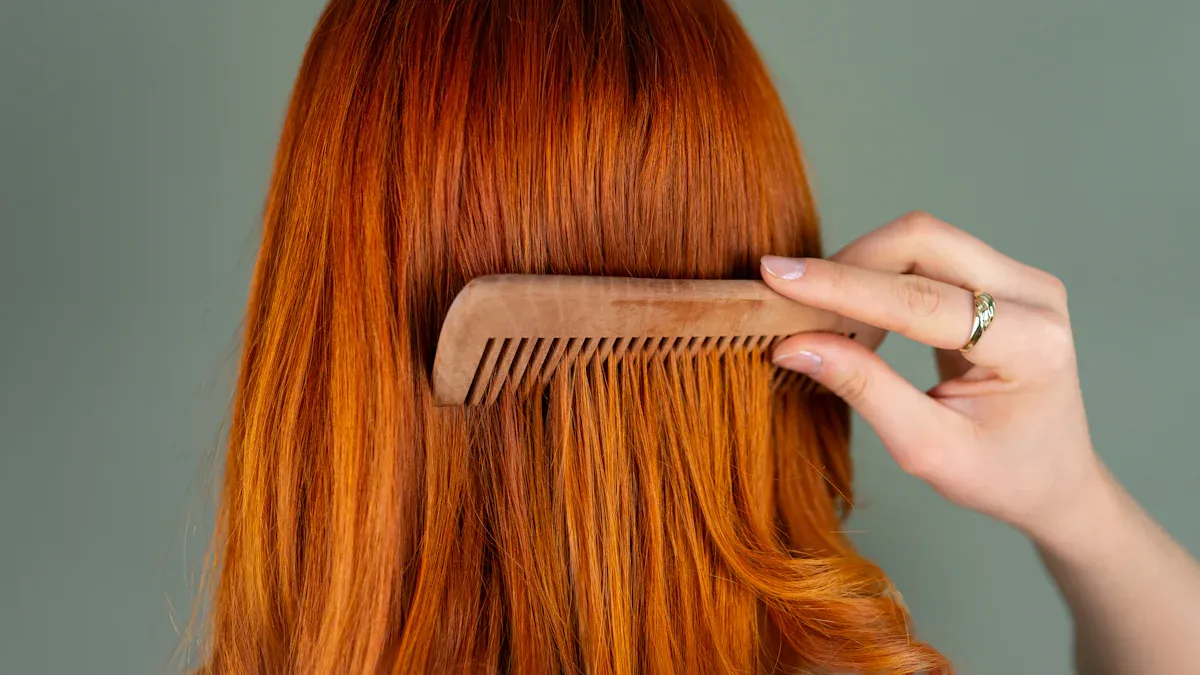
Top Tips for Caring for Your Lace Front Wigs
Share

You want your lace fronts to look fresh and last longer. Proper care makes a huge difference. Stick with gentle routines and always choose products the manufacturer suggests. Handle your wig with care every time. You can keep your wig looking natural and beautiful with just a little effort.
Key Takeaways
Wash human hair wigs every 7 to 10 days. Wash synthetic wigs every 6 to 8 wears. This helps keep them clean and fresh.
Use sulfate-free products made for wigs. These products help avoid damage. They also keep the hair fibers nice.
Be gentle when you put on your wig. Be gentle when you take it off. This stops the lace from stretching or tearing.
Wig Maintenance Essentials
Washing Lace Front Wigs
Keeping your lace front wigs clean is a big part of wig maintenance. You want your wig to look fresh and last longer, so washing it the right way matters. For human hair wigs, you should wash them every 7 to 10 days if you wear them daily. If you only wear your wig sometimes, wash it after each use if you notice sweat or product buildup.
Synthetic wigs need a different routine. Try not to wash them too often. Washing every 6 to 8 wears works best for most people. If you wear your synthetic wig less often, washing every two weeks or once a month is usually enough. This helps keep the fibers strong and the style looking good.
Tip: Always remove your wig before bed or use a silk scarf if you can’t take it off. This helps prevent tangling and damage.
Choosing the Right Products
Picking the right products is key for good wig maintenance and care. Not all shampoos and conditioners work for lace fronts. You should use sulfate-free shampoo and conditioner made just for wigs. These products clean your wig without harming the lace or hair fibers. For synthetic wigs, use products that match the wig type. For human hair wigs, stick with gentle, nourishing formulas.
Stay away from harsh chemicals. They can cause damage that you can’t fix. Always have a clean towel and a wig stand or mannequin head ready for drying. This keeps your wig in shape and helps it dry evenly.
Gentle Handling of Lace Fronts
Putting On and Removing Wigs
You want your lace front wig to last, so always handle it with care. When you put on your wig, start by making sure your hands are clean. Hold the wig by the ear tabs or the back, not the lace. This keeps the lace from stretching or tearing. Gently place the wig on your head and adjust it until it feels comfortable. Never pull or tug on the lace.
When it’s time to remove your wig, use a gentle adhesive remover if you use glue or tape. Let the remover sit for a few seconds. Slowly lift the lace from your skin. Don’t rush this step. If you feel resistance, add more remover and wait a bit longer. This helps keep the lace strong and prevents rips.
Tip: Always clean off any leftover adhesive from your wig before washing it. This keeps the lace in good shape and makes cleaning easier.
Avoiding Damage to Lace and Hair
You can keep your lace fronts looking great by avoiding some common mistakes. Here are things you should watch out for:
Combing or styling your wig while it’s still wet
Using too much hair product
Forgetting to remove adhesive before washing
Washing with very hot water
Brushing from root to tip instead of starting at the ends
Take your time when you brush or style. Start at the tips and work your way up. This helps prevent shedding and keeps the hair smooth.
Here’s a quick guide to gentle handling:
Care Aspect |
Recommendation |
|---|---|
Washing and Drying |
Handle the lace gently to avoid tearing; air dry to prevent stretching. |
Adhesive Care |
Clean the lace after each wear to remove adhesive residue and prevent buildup. |
Storage |
Use a wig stand or satin bag to protect delicate lace materials. |
Gentle handling makes a big difference. You’ll notice your wig stays looking natural and lasts much longer.
Proper Wig Styling

Brushing and Detangling
You want your wig to look smooth and last longer. Brushing and detangling the right way can help you avoid shedding and breakage. Always handle your wig gently. Use clips or pins made for wigs to keep the lace safe. When you brush, start at the ends and work your way up. This keeps the hair from breaking and helps you get rid of knots without pulling.
Here are some tools you can use for brushing and detangling:
Wide-tooth combs work best for synthetic wigs and for detangling before you wash.
Bristle brushes help human hair wigs stay soft and shiny.
Wire-wig brushes glide through synthetic wigs without pulling.
Detangling brushes have flexible bristles that work for all wig types.
Sculpting brushes add volume and style without causing damage.
Tip: Take your time when you detangle. Rushing can cause more knots and damage.
Heat Protection for Lace Front Wigs
If you like to style your lace fronts with heat, you need to protect them. Always check the manufacturer's guide before you use any hot tools. Most lace front wigs can handle heat between 300-350 degrees Fahrenheit. Never go higher than this, or you might damage the hair.
Try these products to keep your wig safe during heat styling:
Hot Tools Professional 24K Gold Curling Iron for heat-safe wigs
Dyson Airwrap Multi-Styler for gentle curls
Jon Renau Heat Treat Thermal Spray for synthetic wigs
SheaMoisture Mousse for smoothing edges
Use a heat protectant spray every time you style. This simple step can make your wig last longer and keep it looking great. Good wig styling and care help you enjoy your favorite looks without worry.
Safe Wig Removal
Removing Lace Front Wigs at Night
You want your wig to last, so safe wig removal at night is important. Start by washing your hands. This keeps dirt and oil away from your lace. Use a gentle adhesive remover if you use glue or tape. Spray or dab the remover along the hairline. Wait a few seconds. You will feel the lace loosen. Gently lift the lace from your skin. Never pull or rush. If you feel any tugging, add more remover and wait again. Safe wig removal helps you avoid tears and keeps your lace fronts looking great.
Tip: Make wig removal part of your nightly routine. Your scalp will thank you, and your wig will stay in better shape.
Cleaning the Lace After Removal
After you finish wig removal, you need to clean the lace. This step keeps your wig fresh and ready for the next wear. Lay your wig flat on a clean towel. Use a cotton swab or soft cloth with a little adhesive remover. Gently wipe away any glue or tape left on the lace. Take your time. Rinse the lace with cool water to remove any leftover product. Pat the lace dry with a towel. Let your wig air dry on a stand. Good care after wig removal helps your lace fronts last longer and look natural.
Always store your wig in a safe place after cleaning.
Avoid folding or crushing the lace.
Storing Lace Front Wigs

Using Mannequin Heads or Silk Bags
You want your lace front wig to keep its shape and style. The way you store it matters a lot. Mannequin heads work great for this. They help your wig stay upright and keep its natural look. You also get better airflow, which helps your wig dry and stay fresh after cleaning. Mannequin heads make it easy to style your wig and stop tangling before it starts.
Silk bags are another smart choice, especially if you need to save space or travel. Silk keeps your wig safe from dust and helps prevent static. You can use a hairnet before placing your wig in the bag. This keeps the hair in place and stops knots from forming. Both options protect your wig and make daily care easier.
Tip: Always store your wig away from sunlight and dust. Sunlight can dry out human hair wigs and damage synthetic wigs. Dust can make your wig look dull and shorten its life.
Preventing Tangling and Shape Loss
You want your wig to look good every time you wear it. Preventing tangling and shape loss is simple if you follow a few steps:
Place your wig on a mannequin head or wig stand when not in use.
Use a hairnet to keep the hair smooth and in place.
For long wigs, braid the ends before storing.
Choose breathable storage like silk bags or wig stands to stop mildew.
Avoid folding or crushing your wig.
Improper storage can cause shedding, matting, and tangling. Over time, sunlight, humidity, and heat can weaken the fibers. Good storage habits help your wig last longer and look its best.
Professional Wig Care
Visiting a Stylist for Maintenance
Sometimes, you need a little extra help to keep your lace front wig looking its best. A professional stylist knows how to handle delicate lace and can spot problems before they get worse. You might notice your wig feels loose or the lace starts to lift. A stylist can fix these issues quickly. They also use special tools and products that you may not have at home.
When you think about cost and results, here are a few things to keep in mind:
Professional maintenance services usually cost more at first because stylists have special skills.
At-home care saves money over time. You can make your wig last longer and avoid frequent trips to the salon.
Some stylists charge less, but you should always check their experience before booking.
Tip: Visit a stylist every few months for a deep clean or repair. This keeps your wig in top shape.
Getting Professional Wig Styling
You might want a new look or a special style for an event. A professional stylist can help you try curls, waves, or even a new color. They know how to style lace front wigs without causing damage. You can ask for tips on daily care, too. Watching a pro work gives you ideas for your own routine.
A stylist can also trim the ends or add layers. This keeps your wig looking fresh and natural. If you want to try something bold, like highlights or a new part, a pro can do it safely. You get peace of mind knowing your wig is in good hands.
Routine Checks for Lace Fronts
Inspecting for Loose Lace or Shedding
You want your wig to look its best every day. Routine checks help you spot problems early. Start by looking at the lace along your hairline. If you see any tears or spots where the lace lifts, you may need to fix it soon. Check for hair shedding by gently running your fingers through the wig. If you notice extra hair coming out, it’s time to take action.
Here are some simple ways to keep your lace fronts in great shape:
Use wide-tooth combs or soft brushes. Fine-tooth combs and stiff brushes can pull out hair.
Avoid tight ponytails or braids. These styles put stress on the lace and hair.
Wash your wig gently. Move your hands in a downward motion and blot dry with a soft towel.
Change your part or style sometimes. This stops stress from building up in one spot.
Ask a professional for help if you want to color your wig.
Watch out for these signs of wear:
Rough removal or sticky glue spots
Over-styling or too much heat
Snags from jewelry or clothes
Tip: Regular checks make wig care easier and help your wig last longer.
Refreshing Adhesive and Fit
A good fit keeps your wig comfortable and secure. Check the adhesive along your hairline every few wears. If you feel the lace lifting or see glue buildup, clean the area and add fresh adhesive. Always use products made for lace wigs. If your wig feels loose, adjust the straps or clips inside. A snug fit protects the lace and helps your style stay in place. Taking a few minutes for these checks can save you time and money later.
Taking care of your lace front wig keeps it looking real and helps it last. When you follow these tips, you save money and avoid buying new wigs often.
Regular care by a stylist makes your wig last longer.
Good habits help synthetic wigs stay soft and shiny.
Start your routine today and enjoy beautiful hair every day! ✨
FAQ
How often should you wash your lace front wig?
You should wash your wig every 7 to 10 wears for human hair. For synthetic wigs, wash every 6 to 8 wears. Always check for buildup.
Can you sleep with your lace front wig on?
You can, but it is not the best idea. Sleeping with your wig on can cause tangling and damage. Try to remove it before bed.
What should you do if your lace starts to lift?
Gently clean the area. Add a small amount of adhesive or wig tape. Press the lace down for a secure fit. Avoid pulling or stretching the lace.
